| Sexual Reproduction in Flowering Plants Refresher Course |
| Sexual Reproduction in Flowering Plants Concepts Files |
| Sexual Reproduction in Flowering Plants Master Files |
| Sexual Reproduction in Flowering Plants Revision Note |
| Sexual Reproduction in Flowering Plants Note 1 |
| Sexual Reproduction in Flowering Plants Reference Book |
Table of Content
- How do plants grow and Reproduce?
- How plants can reproduce Asexually?
- Sexual Reproduction
- Flower: “The main reproductive organ of a plant”
- Development of male Gametophyte or Microsporogenesis
- Gynoecium
- Development of Female Gametophyte/Embryo sac or Megasporogenesis
- Post Fertilization Stages
- Apomixis and Polyembryony
- Pollination
- Agents for Pollination
Reproduction is defined as the formation of new individuals or offspring by sexual or asexual means.
How do plants grow and Reproduce?
Plants need water along with minerals, sunlight, carbon-dioxide, and chlorophyll (green pigment in leaves) to grow. These components are essential for photosynthesis. Apart from these, plants also need proper space, nutrients for growth.
There are two types of reproduction in plants- Asexual reproduction and Sexual reproduction.
How plants can reproduce Asexually?
Asexual reproduction is a mode of reproduction in which a new organism arises from a single parent. Some plants reproduce asexually. Vegetative reproduction/ propagation is the most common type of asexual reproduction. New individuals are formed without the formation of seeds. For example, in herbaceous and woody perennial plants. Vegetative reproduction may arise from many parts of the plants including leaves and underground stems. For example, rhizomes are underground stems that reproduce asexually by vegetative reproduction.
Advantages of Vegetative Reproduction
- Less time and energy is needed
- No mates are required
Disadvantages of Asexual Reproduction
- No variation as offspring are clones of their parents
- They are more prone to extinction
Sexual Reproduction
It involves fusion of male and female gamete by a process of fertilization. It involves mixing of genes from both the parents.
Flower: “The main reproductive organ of a plant”
Flower consists of 4 main parts- calyx (sepals), corolla (petals), androecium (stamens) and gynoecium (carpels).
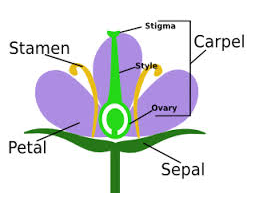
Fig.1. Parts of a Flower
Androecium is the collection of the stamens of the flower. Stamens are the male reproductive organs of the flower. Stamen is made up of anther and the filament. The long stalk-like structure is known as filament whereas bilobed, terminal structure is known as anther.
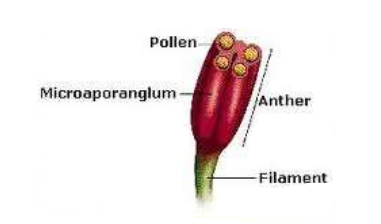
Fig.2. Structure of stamen
Anther is a bilobed structure with two theca, such anther is known as dithecous anther. Each lobe of an anther contains two sporangium known as microsporangium. It is site of pollen grains formation.
Microsporangium in circular in nature when viewed transversally. Four layer surrounds it- epidermis, endothecium, middle layers and tapetum.
The epidermis, endothecium and middle layers are protective in function. They also help in release of pollen grains from the anther. The process of release of pollen grains from the anther is known as dehiscence. The innermost layer known as tapetum plays an important role in providing nourishment to the growing pollen grains. Tapetum is multinucleated and with dense cytoplasm.
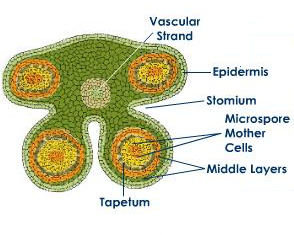
Fig.3. Transverse section of anther
Development of Male Gametophyte or Microsporogenesis
The formation of microspores or pollen grains inside the microsporangium is known as microsporogenesis. When the anther is young, a layer of homogenous cells occupies the center of each microsporangium, is known as sporogenous tissue. It is diploid in nature. The sporogenous tissue undergo meiotic divisions to form microspore tetrads (four microspores) which are haploid. These microspores mature to form pollen grains, male gametes. Each microsporangium contains thousands of microspores or pollen grains.
Pollen grains are spherical structures with two layered wall. The outer exine and inner intine. The exine is covered by the deposition of sporopollenin. Sporopollenin is a resistant layer made up of organic substances. It can withstand high temperature and pressure. Exine contain apertures known as germ pores, where sporopollenin is absent. The inner wall intine is made up of polysaccharide known as pectin and cellulose.
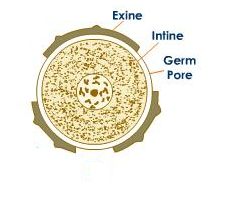
Fig. 4. Structure of Pollen Grains
As the pollen grain matures, it is made up of two types of cells- vegetative cells and generative cells. The large cell is vegetative cell with stored reserve material and smaller cell is known as generative cell which matures to form male gametes.
Gynoecium
It is the female reproductive part of the flower. Pistil is made up of stigma, style, and ovary. Stigma is the place where pollen grains lands.
The swollen base of the pistil is known as ovary. Placenta is located inside the ovarian cavity. Arising from the placenta is the megasporangia where ovules or megaspores are formed. The place where megaspores are formed are known as megasporangium.
Ovule is attached to the placenta via stalk known as funicle. The point where ovule fuses with the stalk is known as hilum. Ovule is covered by a protective covering known as integuments. Within the integument, a mass of cells is present which is known as nucellus. Integuments encircle the nucellus except at a point which is known as micropyle.
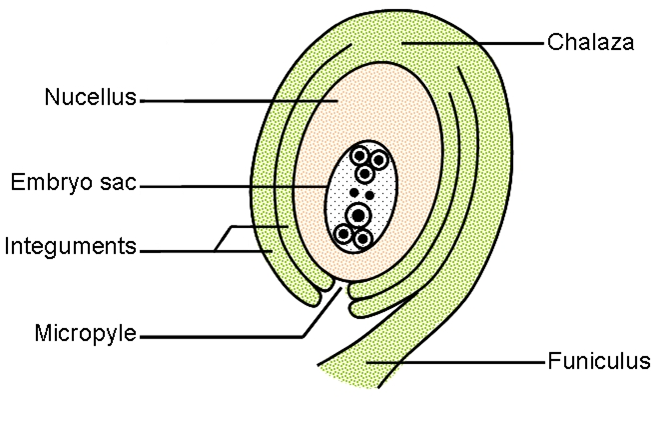
Fig.5. Structure of Ovule
The point opposite to micropyle is known as chalaza. Located in the nucellus is female gametophyte also known as embryo sac. The formation of megaspores is known as megasporogenesis.
Development of Female Gametophyte/Embryo sac or Megasporogenesis
The megaspore mother cell (diploid cell) divides meiotically to form four megaspores. Out of these four megaspores, three degenerates and one remains functional. This type of development where one functional megaspores forms the female gametophyte is known as monosporic development. The functional megaspores divide mitotically to form 2-celled embryo sac. Further subsequent mitotic division finally forms 8-celled embryo sac.
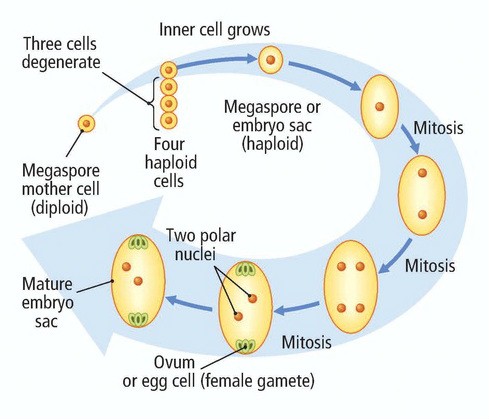
Fig. 6. Development of Embryo Sac
Six of the eight nuclei are surrounded by cell walls and organized into cells; the remaining two nuclei, called polar nuclei are situated in the large central cell. Three cells at the micropylar end forms the egg apparatus. The egg apparatus is made up of two synergids and one egg cell.
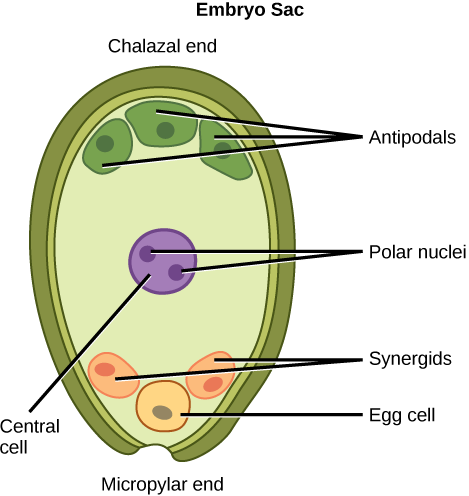
Fig.7. Structure of Embryo Sac
Three cells at the chalazal end is known as antipodals. So, the mature embryo sac is 7 celled and 8 nucleated.
When pollen lands on the stigma of the flower, it forms the pollen tube that adheres down towards the ovary via style. The pollen tube enters the ovary through the micropyle end. The pollen tube releases the two male gametes in the female gametophyte. One sperm fertilizes the egg cell and the other sperm fuses with the two polar nuclei of the large central cell of the megagametophyte. The haploid male gamete and haploid egg combine to form a diploid zygote, while the other male and the two haploid polar nuclei of the large central cell form a triploid nucleus or endosperm. This is known as Double Fertilization.
Double fertilization is a characteristic feature of angiosperms. It was first discovered by Sergei Nawaschin in Lilium Martagon and Fritillaria Tenella.
Post Fertilization Stages
The most important structure formed after double fertilization is endosperm. Endosperm is triploid in nature and serves for the nourishment of the growing embryo. The cells of this tissue store reserve food materials. Endosperm is sometimes completely consumed during embryo development as in case of pea, groundnut, beans etc. or sometimes persist in the mature seed, for example, castor, coconut etc.
Embryo
Zygote forms the embryo. The zygote divides to form pro-embryo. Pro-embryo later converts into globular, heart shaped and finally mature embryo. A dicot embryo consists of embryonal axis with two cotyledons. The portion of embryonal axis which is above the level of cotyledons is the epicotyl. Epicotyl give rise to plumula or stem tip. The portion below the level of cotyledons is hypocotyl. Hypocotyl terminates at its lower end in the radicle or root tip. The root tip is covered via root cap. Root cap is involved in perception of gravity. It protects the root tip.
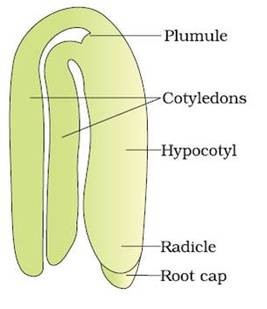
Fig.8. Embryo of Dicots
Monocots have only single cotyledons. The cotyledon of monocot such as in case of grasses, is known as scutellum. At its lower end, the embryonal axis has the radical and root cap enclosed in an undifferentiated sheath called coleorhiza. The portion of the embryonal axis above the level of attachment of scutellum is the epicotyl. Epicotyl has a shoot apex which is enclosed in hollow structure known as the coleoptile.
Seed
The result of sexual reproduction in flowering plants is seed. Seeds are formed within the fruit. Seed comprises of seed coat, cotyledons and embryonal axis. The cotyledons are thick and swollen. A mature seed can be ex-albuminous or non-albuminous seed. Albuminous seeds retain a part of the endosperm during embryo development. For example, wheat, maixe, barley etc. The left-over part of the embryo is known as perisperm. In case of non-albuminous seed, the endosperm is completely consumed during embryo development. For example, pean and groundnut.
Ovules mature into seed and ovary develops into fruit. The wall of the ovary develops into wall of fruit known as pericarp.
There are two types of fruits- true fruits and false fruits. Fruits that develop from the ovary are known as true fruits. The fruits which arises other than the ovary is known as false fruits such as apple, which arises from the thalamus. Certain fruits are formed without fertilization; such a process is known as parthenocarpy. For example, banana is a parthenocarpic fruit.
Apomixis and Polyembryony
Seeds formed without fertilization are known as apomixes. So it is a form of asexual reproduction that mimics the sexual reproduction. For example, grasses and some members of Asteraceae family.
When more than one embryo is present in a seed is known as polyembryony. For example, in Citrus and Mango.
Pollination
The transfer of the pollen grains from the anther to the stigma of the flower is known as pollination.
Types of Pollination are as follows
- Autogamy also known as self-pollination. It is the transfer of pollen grains from the anther to the stigma of the same flower. For autogamy, anthers and stigma should be close to each other. Some plants have two types of flowers- chasmogamous flowers which are similar to flowers of other species with exposed anthers and stigma, and cleistogamous flowers which never opens. For example, Oxalis, Commelina.
- Geitonogamy is the transfer of the pollen grains from the anther to the stigma of another flower of the same plant.
- Xenogamy is the transfer of pollen grains from the anther to the stigma of different flower of different plant. This is also known as cross-pollination. In this case, two genetically different flowers are involved.
Agents for Pollination

Fig.9. Biotic and abiotic agents of pollination
There are two types of agents that are involved in pollination-abiotic and biotic agents. The main agents for pollination are biotic. Abiotic agents includes-wind and water. The chance for landing of pollen on the compatible stigma of the flower is lower in case of abiotic agent as compared to biotic agents for pollination. For wind pollination, the pollen should be light as well as non-sticky. They have well exposed stamens with feathery stigma. This type of pollination is more common in grasses. Pollination by water is rare and it occurs only in monocots. Wind pollinated flowers are generally colorless, small, light, smooth etc. Pollen grains are sometimes ribbon-like for easy transport via water.
Biotic agents include animals as the agents for pollination. Pollination by insects is known as entomophily. The insect pollinated flowers are usually colorful, with fragrance, full of nectar etc. The flowers which are pollinated by flies, beetles secrete foul odor to attract these animals for pollination. When these animals come in contact of these flowers, their body get stacked with pollen. When these animals come in contact with the stigma, they bring about the pollination.
Outbreeding Devices
Repeated self-pollination leads to inbreeding depression. Repeated inbreeding leads to the decrease in biological fitness of the individuals in a population. To prevent this, flowering plants have developed certain devices.
These devices include:
- Either the pollen is released before the stigma becomes accessible.
- Stigma becomes accessible much before the release of pollen.
- The anther and stigma are placed at different positions so that the pollen is unable to approach the stigma of the same flower.
- The third device to prevent inbreeding is self-incompatibility.
- Production of unisexual flowers is also one of the method to prevent inbreeding.
- Male and female flowers are present at different plants.
Artificial Hybridization
This is a method used for crop improvement. It uses desired pollen grain to reaches the stigma of the flower. This is achieved through two methods- emasculation and bagging techniques.
Emasculation is the process of removal of anthers from the bisexual flowers. Emasculated flowers are covered with a bag made up of butter paper. This is done to prevent the contamination of stigma with unwanted pollen.